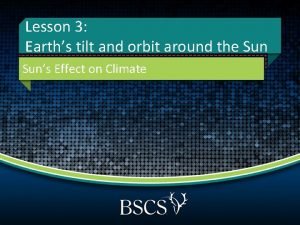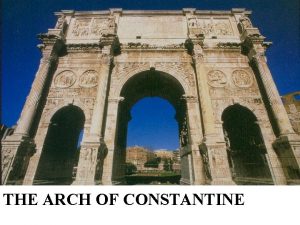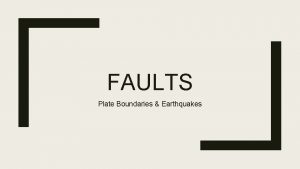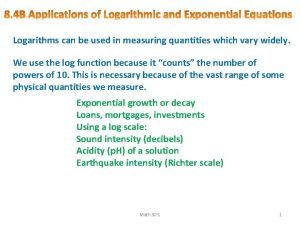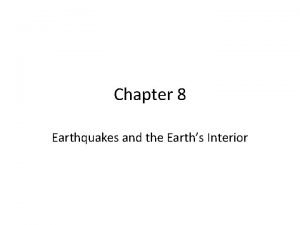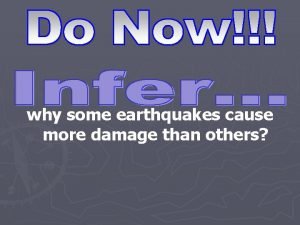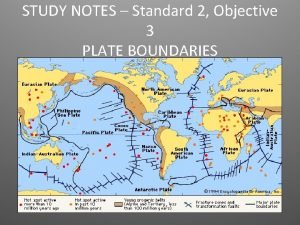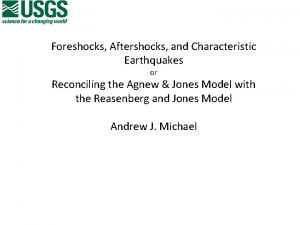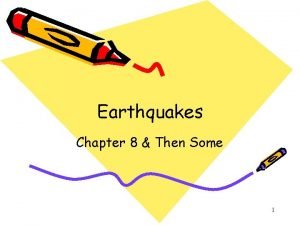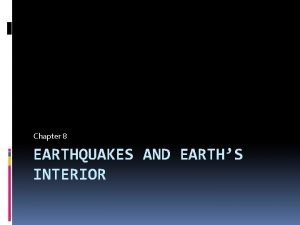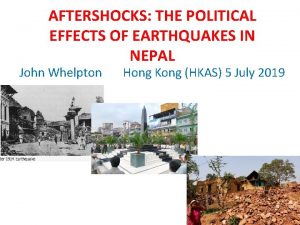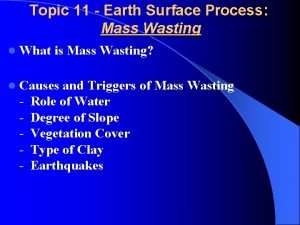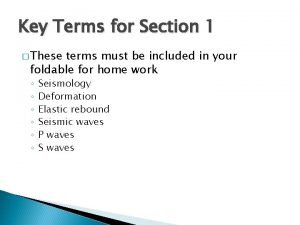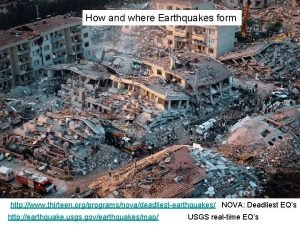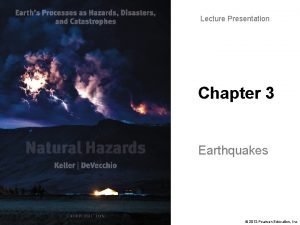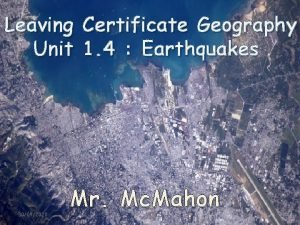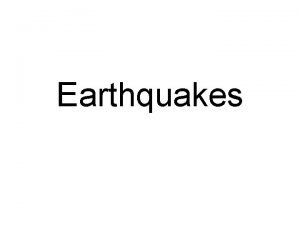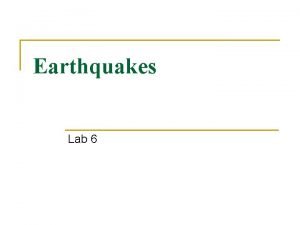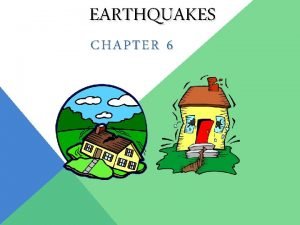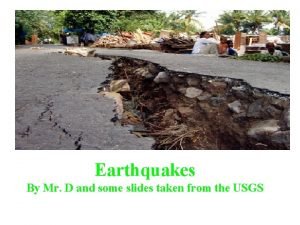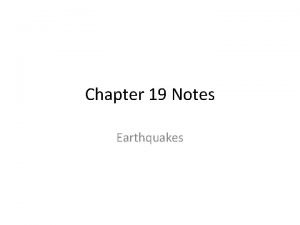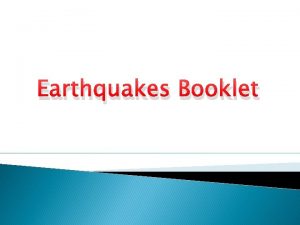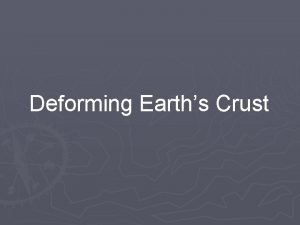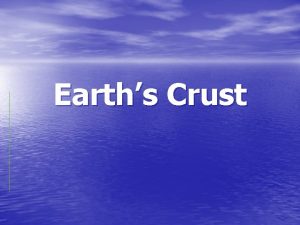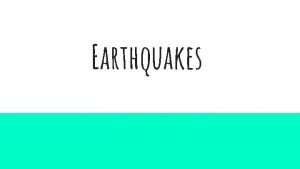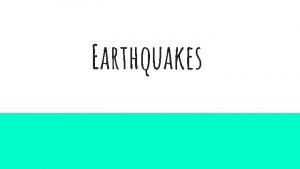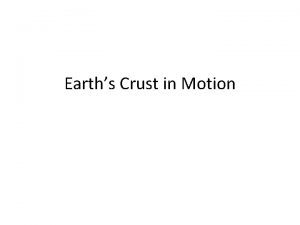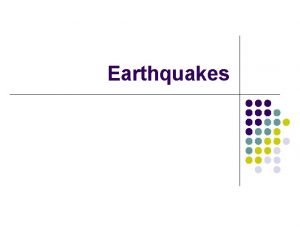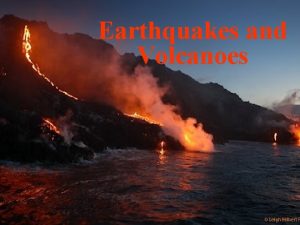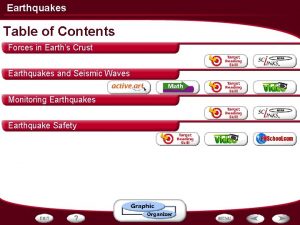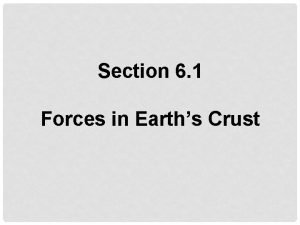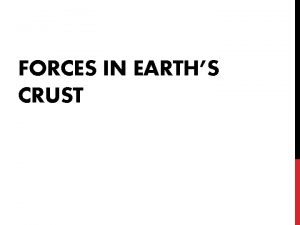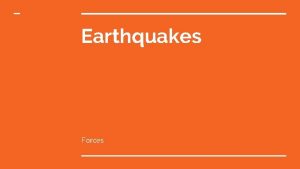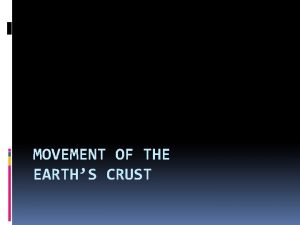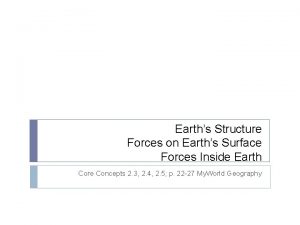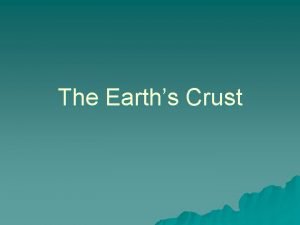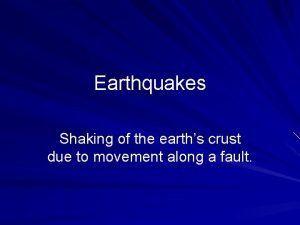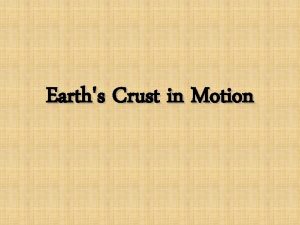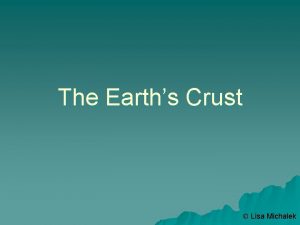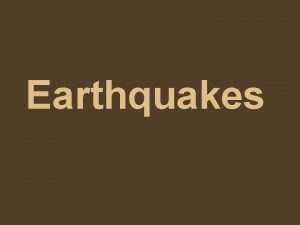EARTHQUAKES FORCES IN EARTHS CRUST How does stress































































- Slides: 63

EARTHQUAKES FORCES IN EARTH’S CRUST

How does stress change Earth’s crust? Stress is a force that acts on rock to change its shape or volume. Stress= force / unit of area Pressure = Force / Area

The movement of Earth’s plates can create strong forces that slowly bend or fold many rocks like a caramel candy bar.


An earthquake is the shaking of the ground cause by seismic waves.

Tension, compression and shearing work over millions of years to change the shape and volume of a rock.


TENSION occurs where two plates pull apart. The stress force that pulls on the crust and thins rock in the middle is called tension.

COMPRESSION occurs where two plates come together. The stress force that squeezes rock until it folds or breaks.

SHEARING occurs where two plates slip past each other. Shearing can cause rock to break and slip apart or to change its shape.


HOW DO FAULTS FORM? When enough stress builts up in rock, the rock breaks, creating a fault.

Normal Fault. - Rock is pull apart by tension. The fault cuts through rock at an angle, so one block sits over the fault ( hanging wall) and the other block lies under the fault ( footwall). RIO GRANDE RIVER flows through a wide valley in Mexico.

NORMAL FAULT

REVERSE FAULTS. - The blocks move in the reverse direction. The hanging wall moves up and the footwall moves down. R. F. form where compression pushes the rock of the crust together. The northern Rocky Mountains rise high above the Western United States and Canada.


STRIKE-SLIP FAULT. – The rocks slip past each other sideways, with little up or down motion. They form when compression pushes the rock of the crust together. The hilly plains in Southern California. San Andreas fault is an example of a transform boundary.

Type of faults

SAN ANDREAS FAULT

1 1. 2. 2 3 Normal Fault. - hanging wall slips down relative to the footwall. Reverse Fault. -The hanging wall moves up relative to the footwall. 3. Strike-slip fault Rocks on either side 4. Of the fault move past to each other.

Plate movements create new landforms Over millions of years, the forces of plate movement can change a flat plain into features such as : anticlines and synclines, folded mountains, fault-block mountains, and plateaus.


ANTICLINE

ANTICLINE

FOLDS are bends in rock that form when compression shortens and thickens Earth’s crust. A fold can be a few centimeters across or hundreds of kilometers wide.


ANTICILINES AND SYNCLINES ( By Compression forces) Upward and downward fold in rock. A fold in rock that bends downward in to form a V shape is a syncline. The central Appalachian Mountains in Pennsylvania.


EARTHQUAKES PLATE MOVEMENT

SYNCLINES

SYNCLINES

FOLDED MOUNTAINS Collision of plates , compression and folding of crust over a wide area. Largest Mountain Ranges: Himalayas ( Asia ), Alps ( Europe )

FOLDED MOUNTAINS

Folded mountains/ anticiclines

Salt Lake City to Los Angeles Cross the Great Basin , region with many mountains, valleys or basins. Region formed by tension and faulting. Fault-block mountains formed where two plates move away from each other.

SALT LAKE CITY/ UTAH

GREAT BASIN. NEVADA

GREAT BASIN NATIONAL PARK NEVADA

GREAT BASIN /NEVADA

PLATEAUS Large area of flat land elevated high above sea level. Forces that raise mountains , uplift a large flat block of rock ( crust). Plateaus have many different flat layers. Colorado Plateau in the “Four Corners” , regions of Colorado, Utah , Colorado and New Mexico.

COLORADO PLATEAU

LESSON 2

EARTHQUAKE is the shaking and trembling that results from movement of rock beneath Earth’s surface.

LOMA PRIETA. - SAN FRANCISCO

SEISMIC WAVES are vibrations, that are similar to sound waves. They travel through Earth carrying energy released by an earthquake.


TYPES OF SEISMIC WAVES • Focus point • Epicenter • P waves. - waves that compress and expand • S Waves. - waves that vibrate side to side. Vibrations at an angle 90 to the direction that they travel.




P Waves travel through liquids and solids. S waves can not move through liquids. S waves reached the surface and shake structures violently. Surface waves are P or S waves that reach the surface. S. W. move more slowly than P or S waves, but they can produce sere ground movements.

KABUL INDU KUSH REGION ( AFGHANISTAN )

Most earthquakes start in the lithosphere within about 100 Km. beneath Earth’s surface. Seismic Waves carry energy.

P WAVES CAN VIBRATE THE GROUND SIDE TO SIDE S WAVES CAN MAKE THE GROUND ROLL LIKE THE OCEAN WAVE SURFACE WAVES CCOMPRESS AND EXPAND THE GROUND

SEISMOGRAPH is an instrument that records and measures an earthquake’s seismic waves.


The magnitude or size of an earthquake is measured on a seismograph using the RICHTER scale.



The amount of earthquake damage or shaking is rated using the Modified Mercalli scale.



The Moment Magnitude Scale rates the total energy an earthquake releases.
 Periodic table of elements families
Periodic table of elements families Plasticity in earth's layers
Plasticity in earth's layers How thick is earths crust
How thick is earths crust Earths crust
Earths crust Spring earth tilt
Spring earth tilt What does earths tilt do
What does earths tilt do True stress and engineering stress
True stress and engineering stress Normal stress
Normal stress Chapter 10 stress responses and stress management
Chapter 10 stress responses and stress management The earth's layers foldable
The earth's layers foldable Earths roation
Earths roation Whats earths moon called
Whats earths moon called Earths biomes
Earths biomes Whats earths moon called
Whats earths moon called Earth's thickest layer
Earth's thickest layer Earths early atmosphere contained
Earths early atmosphere contained Earths major crustal plates
Earths major crustal plates Earths orbit seasons
Earths orbit seasons Brown earth soil profile
Brown earth soil profile Study of earth's physical features
Study of earth's physical features Earth's honey
Earth's honey What is luna moon
What is luna moon Continental drift theory notes
Continental drift theory notes Earths interior
Earths interior Structure of atmosphere
Structure of atmosphere Describe the true shape of earth's orbit
Describe the true shape of earth's orbit Arch of constantine frieze
Arch of constantine frieze Earths boundaries
Earths boundaries Earths 4 spheres
Earths 4 spheres In what section of earth do earthquakes happen?
In what section of earth do earthquakes happen? Btn earthquakes
Btn earthquakes Chapter 8 section 3 earthquakes and society answer key
Chapter 8 section 3 earthquakes and society answer key Define natural disaster
Define natural disaster Http://earthquake.usgs.gov/earthquakes/map/
Http://earthquake.usgs.gov/earthquakes/map/ Chapter 8 earthquakes and volcanoes
Chapter 8 earthquakes and volcanoes A large crack in the earth formed by a river or earthquakes
A large crack in the earth formed by a river or earthquakes Chapter 8 earthquakes and earth's interior
Chapter 8 earthquakes and earth's interior Chapter 19 earthquakes
Chapter 19 earthquakes Why some earthquakes cause more damage than others
Why some earthquakes cause more damage than others Frequent earthquakes in an area may indicate
Frequent earthquakes in an area may indicate Earthquakes
Earthquakes Quiz 1 earthquakes
Quiz 1 earthquakes Chapter 8 earthquakes and earth's interior answer key
Chapter 8 earthquakes and earth's interior answer key Earthquakes
Earthquakes Crescent-shaped cliffs at the head of a slump
Crescent-shaped cliffs at the head of a slump Elastic rebound theory
Elastic rebound theory Why do earthquakes occur
Why do earthquakes occur Do earthquakes happen
Do earthquakes happen Pearson education
Pearson education Richter magnitude scale
Richter magnitude scale Where do earthquakes occur? *
Where do earthquakes occur? * Diastrophic forces
Diastrophic forces Causes of earthquake in points
Causes of earthquake in points Whats the main cause of most earthquakes
Whats the main cause of most earthquakes Types of earthquake
Types of earthquake Chapter 19 earthquakes
Chapter 19 earthquakes Example of parallel force
Example of parallel force The forces shown above are
The forces shown above are Intramolecular vs intermolecular
Intramolecular vs intermolecular δ+
δ+ Inter vs intramolecular forces
Inter vs intramolecular forces What is contact force
What is contact force Force examples in everyday life
Force examples in everyday life Is erosion constructive or destructive
Is erosion constructive or destructive





